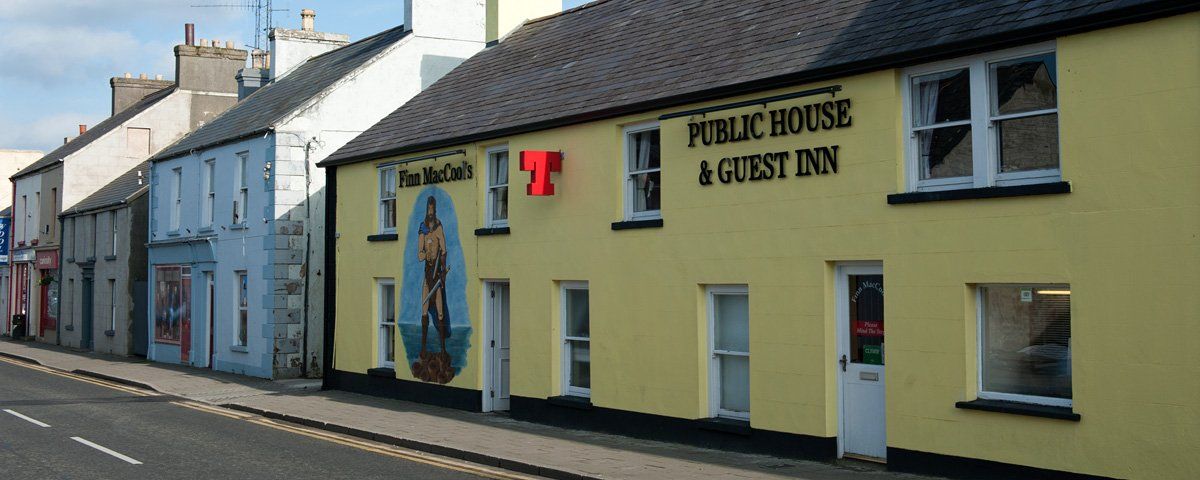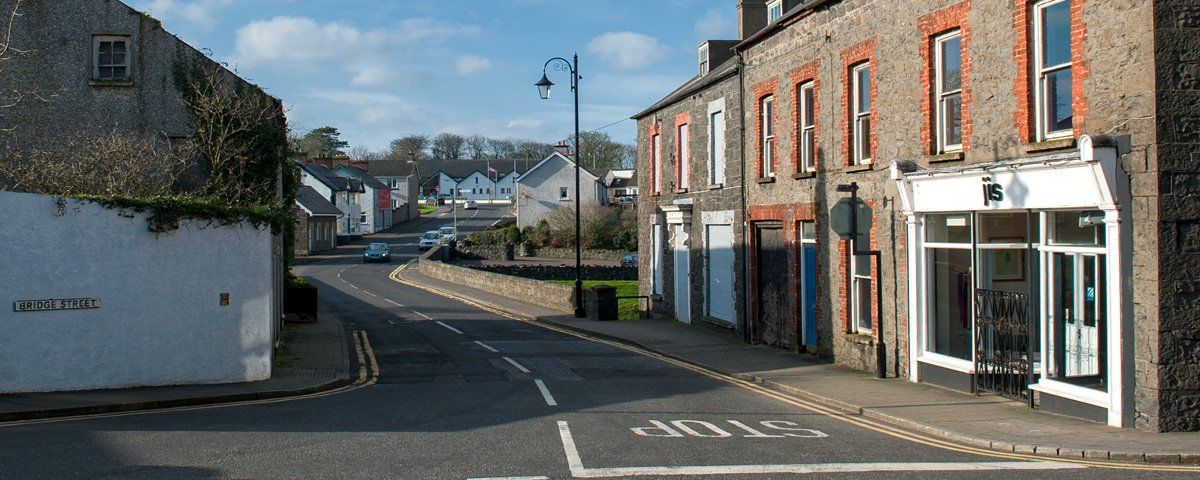About Bushmills
Bushmills was originally a settlement called Portcaman consisting of a few dwellings beside a shallow strategic river crossing. The main centre was at Dunluce Castle where a thriving merchant village existed. This was destroyed during the 1641 uprising, the combination of this destruction and emerging water power industries on the river Bush led to the migration of people to Portcaman, the mills and river brought a new name and a key centre for corn, flax, spade and whiskey production with seven mills in operation, one of the first mills in County Antrim was built here. The Diamond is typical of many traditional Ulster towns and villages where corners are gathering places for the exchange of news and banter, a way of life that passes silently from one generation to another.
The War Memorial is a tribute to the young men who left these same corners and rural fields never to return. Their story and bravery reflected by a few who did return, like Robert Quigg V.C. from the townland of Ardihannon at the Giant's Causeway. The village has a unique North Antrim quality and an authentic local tongue commonly known as Ulster-Scots or Scots-Irish. This uniqueness is marked by the Alphabet Angel the world's first lifesize bronze sculpture that celebrates this unique tongue. A walk along the Main Street or a visit to a traditional shop or pub will reveal the living heritage of the village. As well as being the gateway to the Giant's Causeway the village is home to the Old Bushmills Whiskey Distillery.
The village owes part of its development and character to the Macnaghten family who built many of the prominent buildings including The Market Square, Clock Tower, the Courthouse and Old National School. The once family home at 'Dundarave House' built in 1847 and designed by Charles Lanyon is set amongst woodlands overlooking the village. During the 1800s regular weekly markets took place in the square, a linen market opened here in 1833 and it was also the location for men, women and children to find employment at the twice-yearly Hiring Fair. The village benefited from the influx of visitors coming to see the Giant's Causeway. Local hotels and inns became popular and flourished.
The opening of the world's first hydro-electric tramway in 1883 between Portrush and Bushmills led to another boost for the village, the tram was powered by water turbines at the Walkmill Falls and pioneered by Colonel William Trail and his brother Anthony of Ballyclough. The village produced nails and farming implements including award-winning spades which were exhibited in England and Europe. Bicycles were also made here, the Dunluce was designed and built here and sold all over the province. The world-renown Gwynne Engineering Company began in Bushmills when John Gwynne arrived in 1823 as a spade maker, he married the daughter of the foundry owner Agnes Anderson.
The river Bush is referred to as one of the ten rivers of Ireland encountered by the first settlers, known as 'Inbiur Buosse bruchtait srotha' (River Bush of the bursting torrents). In another, it is referred to for a 'great abundance of nuts which were found on the banks of the Boyne and the Buais (Bush)'. The 'Book of Leinster' tells of a master smithy called Echen who lived here, he had a son called Amergin who was dumb since birth. At the age of fourteen Amergin found his voice and was said to have spoken with great wisdom, he becomes the chief poet to the high king of Ulster and known as 'the good poet from the Buis (Bush) in the north'.
A description of his clothes reads: 'he wore a blue, fine bordered shirt next to the skin, with carved and interlaced clasps of white bronze, with real buttons of burnished red-gold in its opening and breast. He wore above it a cloak mottled with the splendour of all the most beautiful colours'.Bushmills has some wonderful examples of period architecture along its streets, it is also fortunate in having an example of work by the famous architect Clough Williams-Ellis who designed the Old Grammar School in the village and also the Causeway Memorial School. A walking trail has been created by the local community to guide people around the conservation village. The river though, will always be a focal point to the village and a reminder of its past heritage.
Two mills have been renovated back to their original condition with a meticulous eye to detail. Palmer's Mill on the town side of the river, looks the same today as it would have done one hundred years ago when horses and carts brought grain here from the surrounding farms. The renovation stand as a credit to its owner Sam and Jan Huey, an excellent example of how heritage and modern needs can work together within a conservation area. On the opposite bank Curry's Mill has been restored to its former glory, the modern name plaque 'Bonner Mill' was a recent addition. Behind the town's listed frontages lie many of the 'still to be preserved' and 'important' examples of the village's heritage - stables, tailor lofts, coach yards, walled gardens, archways and even a Georgian farmyard.
A well-known attraction of the village is the salmon, each year these ocean travellers navigate their way across the Atlantic back to the Bush. How they find their way remains a natural mystery but if you enjoy watching salmon jumping over rushing torrents of water then a visit to the Walkmill Falls is well worth taking. Here the salmon encounter the biggest obstacle on their long journey home. Years ago the salmon would have been caught by a net between the two bridges, local people recall the banks being lined 'silver with fish', nowadays the runs are not so abundant, the stocks are physically under threat from over-fishing in the North Atlantic. You can still see the old boat slip at Riverside Park where fishermen set the nets from.








